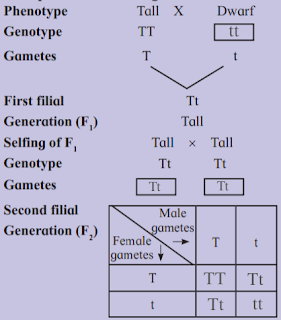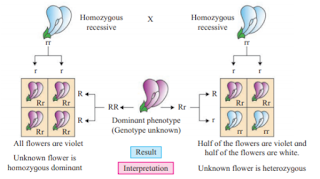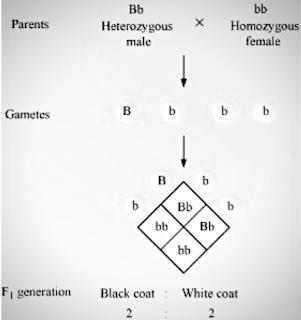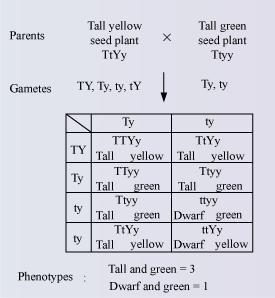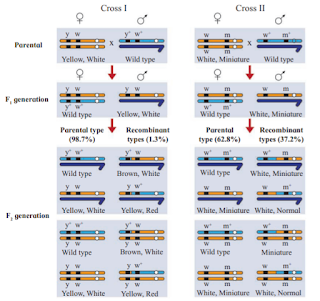Principles of Inheritance and Variation NCERT Solutions
CBSE Class 12 Biology Chapter 5 – NCERT Solutions of Principles of Inheritance and Variation solutions:
Hello, students today we are going to discuss CBSE class 12 biology chapter 5 NCERT solutions Principles of Inheritance and Variation textbook solutions In this article we collected all the questions and answers of CBSE class 12 biology chapter 5 NCERT solutions Principles of Inheritance and Variation with simple answers.
So before starting the questions and answers of Principles of Inheritance and Variation NCERT solutions Class 12 Biology chapter 5 just rewrite it with the important points to remember ……
Important points to remember
- Genetics is a branch of biology that deals with principles of inheritance and its practices. Progeny resembles the parents in morphological and physiological features.
- Mendel was the first to study this phenomenon systematically. While studying the pattern of inheritance in pea plants of contrasting characteristics,
- Mendel proposed the principles of inheritance, which are today referred to as ‘Mendel’s Laws of Inheritance’. He proposed that the ‘factors’ (later named genes) regulating the characters are found in pairs known as alleles.
- The dominant characters are expressed when factors are in heterozygous condition (Law of Dominance). The recessive characters are only expressed in homozygous conditions.
- Different combinations of gametes are theoretically represented in a square tabular form known as ‘Punnett Square’. The factors (now known as genes) on chromosomes regulating the characters are called the genotype and the physical expression of the characters is called the phenotype.
- genes are located on the chromosomes. Many genes were linked to sexes also, and called sex-linked genes. The two sexes (male and female) were found to have a set of common chromosomes and another different set.
- The chromosomes which were different in the two sexes were named sex chromosomes. The remaining set was named autosomes.
- In humans, a normal female has 22 pairs of autosomes and a pair of sex chromosomes (XX). A male has 22 pairs of autosomes and a pair of sex chromosomes as XY.
- In chicken, sex chromosomes in males are ZZ, and in females are ZW.
- The mutation is defined as the change in the genetic material. A point mutation is a change of a single base pair in DNA. Sickle-cell anemia is caused due to change of one base in the gene coding for the beta-chain of hemoglobin.
Principles of Inheritance and Variation NCERT Solutions:
1. Mention the advantages of selecting a pea plant for the experiment by Mendel.
Answer: Mendel is known as the father of genetics because of his ground-breaking work on inheritance in pea plants. Mendel studied inheritance on the pea (Pisum sativum) plant. He chose pea plants because they had been used for similar studies, are easy to grow, and can be sown each year. Pea flowers contain both male and female parts, called stamen and stigma, and usually self-pollinate. Self-pollination happens before the flowers open, so progeny is produced from a single plant.
These plants have a short life span wherein they produce plenty of seeds in one generation alone. Peas can also be cross-pollinated by hand, simply by opening the flower buds to remove their pollen-producing stamen (and prevent self-pollination) and dusting pollen from one plant onto the stigma of another.
2. Differentiate between the following –
(a) Dominance and Recessive
Answer: Dominant: It is an allele that expresses its trait even in the presence of an alternative allele i.e. in heterozygous condition only. Alternatively, the allele that expresses in F1 is called dominant. (It is an allele of a pair that masks the expression of another allele in the F1 generation.) Recessive: This allele is not expressed in the presence of an alternative allele (in heterozygous condition). It expresses only in the presence of another identical allele. It is an allele that does not express in the F1 hybrid.
(b) Homozygous and Heterozygous
Answer: Homozygous (pure): An individual possessing identical alleles for a particular trait, is called homozygous or pure for that trait. Homozygous breeds true to the trait and produces only one type of gametes e.g., tall with TT and dwarf with tt.
Heterozygous: An individual possessing contrasting alleles for a particular trait, is
called heterozygous. Heterozygous does not breed true for that trait and produces two types of gametes e.g. F1 generation hybrids (Tt). The heterozygous individual is also called a hybrid.
(c) Monohybrid and Dihybrid.
Answer :
A Monohybrid cross is a cross between parents differing in only one pair of contrasting characters Dihybrid cross is a cross between parents differing in two pairs of contrasting characters
An example of monohybrid cross– is a cross between a dwarf and a tall pea plant. Example of dihybrid cross – a cross between a yellow wrinkled seed and a green rounded seed.
3. A diploid organism is heterozygous for 4 loci, how many types of gametes
can be produced?
Answer: A locus is a fixed point on a chromosome that is occupied by one or more genes. For an allelic pair, heterozygous entities contain different alleles. Thus, a diploid entity that is heterozygous at four loci has four different contrasting characters at four different loci.
Explanation: Types of gametes produced by organism= 2n whereas n= number of loci for which the organism is heterozygous.
The given diploid organism is heterozygous for 4 loci, types of gametes produced = 2x2x2x2
= 16.
4. Explain the Law of Dominance using a monohybrid cross.
Answer: The law of dominance is used to explain the expression of only one of the parental characters of a monohybrid cross in F1 and the expression of both in F2.
Statement of Law of Dominance: “When two homozygous individuals with one or more sets of contrasting characters are crossed, the alleles (characters) that appear in F1 are dominant and those which do not appear in F1 are recessive”.
Example– When a monohybrid cross between two pea plants having Tall plant (TT) and Dwarf plant (tt) was carried out, all the seeds in the F1 generation were observed to be Tall (Tt). If the round seeds were self-fertilized both the characters – Tall and dwarf plants appeared in the F2 generation in a 3:1 ratio. Therefore, in the F1 generation, the dominant character i.e., the Tall plant surfaced, and the recessive character i.e., the dwarf plant got suppressed that resurfaced in the F2 generation.
5. Define and design a test cross.
Answer: Test cross: The cross of F1
hybrid with the homozygous recessive parent is known as a test cross. It is used to test whether an individual is homozygous (pure) or heterozygous(hybrid). A test cross is easy, simple, repeatable, and predictable. Test cross can be used to find out the genotype of any plant with dominant expression. But it is not known whether it is homozygous (pure) or heterozygous for that trait.
For example, a pea a plant having violet (purple) flowers is crossed with a pea plant with white flowers. If all flowers produced are violet, we can conclude that the plant is pure or homozygous and if we get violet and white flowers in a 1:1 ratio, we can conclude that the plant is heterozygous. A test cross is also used to introduce useful recessive traits in the hybrids of self-pollinated plants during rapid crop improvement programs. Following is the graphic representation of the test cross. The recessive parent is crossed to find out the unknown genotype.
6. Using a Punnett Square, work out the distribution of phenotypic features in the first filial generation after a cross between a homozygous femaleand a heterozygous male for a single locus.
Answer: In guinea pigs, the heterozygous male with black coat color (Bb) is crossed with the female having white coat color (bb). The male will produce two types of gametes, B and b, while the female will produce only one kind of gamete, b. The genotypic and phenotypic ratio in the progenies of the F1 generation will be the same i.e., 1:1.
7. When a cross is made between a tall plant with yellow seeds (TtYy) and tall plant with green seed (Ttyy), what proportions of phenotype in the offspring could be expected to be
(a) tall and green.
(b) dwarf and green.
Answer: When a cross between a tall plant with yellow seeds and a tall plant with green seeds is carried out, the following is produced:
Three tall green plants
One dwarf green plant.
8. Two heterozygous parents are crossed. If the two loci are linked what would be the distribution of phenotypic features in the F1 generation for a dihybrid cross?
Answer: Linkage is defined as the coexistence of two or more genes in the same chromosome. If the genes are situated on the same chromosome and lie close to each other, then they are inherited together and are said to be linked genes.
For example, a cross between a yellow body and white eyes and wild type parent in a Drosophila will produce wild-type and yellow-white progenies. It is because yellow-bodied and white-eyed genes are linked. Therefore, they are inherited together in progenies.
9. Briefly mention the contribution of T.H. Morgan to genetics.
Answer: Thomas Hunt Morgan was an American biologist. He used fruit fly (Drosophila melanogaster) in genetic
research and established the chromosomal theory of heredity. He also discovered
the principle of linkage, sex linkage, and crossing over. Margan’s work played a key role in the field of genetics. He was awarded a Nobel Prize in 1933, in Physiology and Medicine.
The contributions of T.H. Morgan in the field of genetics are as follows:
- Thomas Hunt Morgan proposed and established that genes are positioned on the chromosomes
- He discovered the basis for variations as a result of sexual reproduction
- Thomas Hunt Morgan discovered the concept of linkage and discriminated between linked and unlinked genes
- He stated the chromosomal theory of linkage
- T.H Morgan carried out a study on sex-linked inheritance
10. What is pedigree analysis? Suggest how such an analysis, can be useful.
Answer: analysis of traits in several of generations of a family is called the pedigree analysis. In the pedigree analysis, the inheritance of a particular trait is represented in the family tree over generations. In human genetics, pedigree study provides a strong tool, which is
utilized to trace the inheritance of a specific trait, abnormality, or disease.
11. How is sex determined in human beings?
Answer :
- The chromosomal mechanism of sex determination in human beings is XX-XY type.
- In human beings, the nucleus of each somatic cell contains 46 chromosomes or 23 pairs of chromosomes. Out of these, 22 pairs are autosomes and one pair of sex chromosomes.
- The human female has a pair of XX, homomorphic sex chromosomes while the male has XY, heteromorphic sex chromosomes.
Thus genotype of :
Female = 44 Autosomes + XX
Male = 44 Autosomes + XY
- During gamete formation in males, the diploid germ cells in the testis undergo spermatogenesis to produce two types of haploid sperms, 50% of sperms contain 22 autosoman es and X chromosome while 50% of sperms contain 22 autosomes and a Y chromosome.
- In Females, the diploid germ cells in the ovaries undergo oogenesis to produce only one type of egg. All eggs contain 22 autosomes and an X chromosome. Thus human male is heterogametic and the female is homogametic.
- If sperm containing the X chromosome fertilizes the egg (ovum), then a diploid zygote is formed, which grows into a female child. If sperm containing a Y chromosome fertilizes the egg, then a diploid zygote is formed that grows into a male child.
12. A child has blood group O. If the father has blood group A and the mother’s blood group B, work out the genotypes of the parents and the possible genotypes of the other offspring.
Answer: The blood group characteristic in humans is controlled by three sets of alleles, namely, IA, IB, and i. The alleles, IA and IB, are equally dominant whereas allele, I, is recessive to the other alleles. The individuals with genotype, IA IA and IA i, have blood group A whereas the individuals with genotype, IB IB and IB i, have blood group B. The persons with genotype IA IB have blood group AB while those with blood group O have genotype ii.
Hence, if the father has blood group A and the mother has blood group B, then the possible genotype of the parents will be Father Mother
IA IA or IA i IB IB or IB i
A cross between homozygous parents will produce progeny with the AB blood group. progeny with AB blood group
A cross between heterozygous parents will produce progenies with the AB blood group (IAIB) and O blood group (ii).
13. Explain the following terms with an example
(a) Co-dominance
Answer: In co-dominance, both the alleles (genes) of an allelomorphic pair express themselves equally in F1 hybrids. Such alleles which can express themselves equally independently in hybrids, are called co-dominant alleles. Thus in co-dominance, both alleles are expressed.
A classic example of co-dominance is a coat color in cattle. There are two types one with a red coat (with red color hair) and the other with a white coat (with white hair). When red cattle (RR) are crossed with white castles (WW), F1 hybrids (RW) are roan.
Roans have a mixture of red and white color hair. Thus both traits are expressed equally. In F2 generation red (RR), roans (RW), and white (WW) are produced in the ratio 1:2:1. Thus in Co-dominance, the genotypic and phenotypic ratios are identical
(b) Incomplete dominance.
Answer: Incomplete dominance: In incomplete dominance, both the alleles (genes) of an allelomorphic pair express themselves partially. One allele (gene) cannot suppress the expression of the other allele (gene) completely. In such a case, there is an intermediate expression in the F1 hybrid. A well-known example is the flower color of Mirabilis jalapa. If a red-flowered (RR) plant is crossed with a white-flowered (rr) plant, then F1 offsprings have pink (Rr) flowers.
14. What is point mutation? Give one example.
Answer: A point mutation is a mutation that only affects a single nucleotide of nucleic acid. Point mutations most commonly involve the substitution of one base for another (which changes the complementary base as well in DNA). The term point mutations also include insertions or deletions of a single base pair.
15. Who proposed the chromosomal theory of inheritance?
Answer: In 1902, the chromosomal theory of inheritance was independently put forward by Theodore Boveri and Walter Sutton. This theory states that the chromosomes are present in pairs in somatic cells. During gamete formation, homologous chromosomes pair, segregate, and assort independently during meiosis.
16. Mention any two autosomal genetic disorders with their symptoms
Answer :
1. Thalassemia: Thalassemia is an autosomal, inherited recessive disease. The Haemoglobin molecule is made of four polypeptide chains- 2 alpha (a) and 2 beta (b) chains. The synthesis of alpha chains is controlled by two closely linked genes (HBA1 and HBA2) on chromosome 16 while the synthesis of beta chain is controlled by a single gene (HBB) on chromosome 11.
Symptoms :
In Thalassemia, the person shows symptoms like anemia, pale yellow skin, change in size and shape of RBCs, slow growth and development, dark urine, etc. Massive blood transfusion is needed for these patients.
2. Down’s Syndrome (21st trisomy) :
Down’s syndrome is named after the physician John Langdon Down who first described this autosomal chromosomal disorder in 1866. This Syndrome is caused due to an extra copy of chromosome number 21st. It shows the presence of three copies of the 21st chromosome instead of homologous pair. These individuals will have 47 chromosomes instead of the normal number 46. 21st Trisomy occurs due to non-disjunction or failure of separation of chromosomes (autosomes) during gamete formation. The incidence of non-disjunction is distinctly higher in mothers who are over 45 years old.
Symptoms :
These patients have mild or moderate mental retardation and skeletal development is poor. Distinct facial features like a small head, ears, and mouth, the face is typically flat and rounded with a flat nose, open mouth, and protruding tongue, eyes slant up and out with internal epicanthic folds, flat hands, and stubby fingers and palm is broad with single palmer crease.
We hope you enjoyed these Principles of Inheritance and Variation NCERT Solutions.
Read More:
Chapter 1: Reproduction in Organisms
Chapter 2: Sexual Reproduction in Flowering Plants
Chapter 3: Human Reproduction
Chapter 4: Reproductive Health



